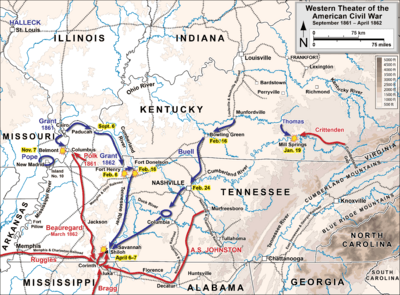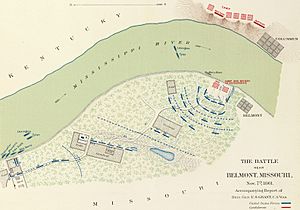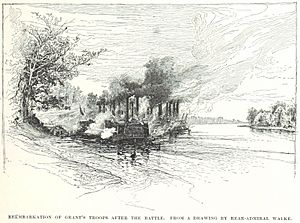Battle of Belmont facts for kids
Quick facts for kids Battle of Belmont |
|||||||
|---|---|---|---|---|---|---|---|
| Part of the Trans-Mississippi Theater of the American Civil War |
|||||||
|
Charleston defenses, Belmont battlefield by Julius Bien & Co., Lith., N.Y. |
|||||||
|
|||||||
| Belligerents | |||||||
| Commanders and leaders | |||||||
| Ulysses S. Grant | Leonidas Polk | ||||||
| Strength | |||||||
| 3,114 | ~17,000 | ||||||
| Casualties and losses | |||||||
| 607
(120 killed;
383 wounded; 104 captured/missing) |
641
(105 killed;
419 wounded; 117 captured/missing) |
||||||
The Battle of Belmont happened on November 7, 1861, in Mississippi County, Missouri. It was the first time Brigadier General Ulysses S. Grant led troops in a real fight during the American Civil War. Grant later became a famous Union Army general and even a U.S. president. In this battle, he faced Confederate Major General Leonidas Polk. Grant's soldiers here formed the core of what would become the Union Army of the Tennessee.
On November 6, Grant traveled by riverboat from Cairo, Illinois. His goal was to attack a small Confederate outpost near Belmont, Missouri. This outpost was across the Mississippi River from a strong Confederate base at Columbus, Kentucky. Grant landed his men on the Missouri side and marched towards Belmont. His troops surprised the Confederate camp and took it over, destroying it.
However, the scattered Confederate soldiers quickly regrouped. They also received help from Columbus. They launched a counterattack, supported by powerful artillery fire from across the river. Grant had to retreat to his riverboats and take his men to Paducah, Kentucky. The battle itself wasn't super important. But because not much else was happening then, it got a lot of attention in newspapers.
Contents
Why the Battle Happened: The Start of Conflict

When the war began, Kentucky was a "border state." This meant it was located between the Union and the Confederacy. Kentucky tried to stay neutral, meaning it didn't pick a side. Its governor supported the Confederacy, but most lawmakers supported the Union.
Even though Kentucky was neutral, soldiers from both sides started moving into the state. Confederate Major General Leonidas Polk moved his forces into Kentucky on September 3, 1861. He took control of Columbus, which was a very important spot on cliffs overlooking the Mississippi River. Just three days later, Union Brigadier General Ulysses S. Grant took over Paducah.
Grant wanted to attack Columbus, but his commander, Major General John C. Frémont, didn't give him permission. For the next two months, there were only small skirmishes.
Grant's Plan to Distract the Confederates
On November 1, Frémont learned that the Confederates planned to send more troops to Arkansas. He ordered Grant to make a fake attack towards Columbus. This was meant to keep the Confederates busy there. Grant sent about 3,000 men into southeastern Missouri.
Grant then found out that Confederate reinforcements were moving into Missouri to stop his troops. So, he sent more soldiers to help. He also ordered Brigadier General Charles Ferguson Smith to move from Paducah into southwestern Kentucky. This was another way to distract the Confederates.
Grant decided to attack Belmont. Belmont was a small ferry landing and a tiny village with only three shacks. It was directly across the river from the strong Confederate base at Columbus. Grant's force had 3,114 officers and soldiers. They were organized into two main groups, plus cavalry and an artillery unit. On November 6, Grant's men left Cairo, Illinois on several steamboats. Two Union gunboats, the USS Tyler and USS Lexington, went with them.
Confederate Major General Leonidas Polk had about 5,000 soldiers defending Columbus. When he heard about Grant's movements, he thought Columbus was the main target. He believed Belmont was just a trick. So, he sent 2,700 men under Brigadier General Gideon J. Pillow to Belmont. He kept the rest of his troops to defend Columbus.
When Grant reached Belmont, he found Camp Johnston. This was a small Confederate observation post with some artillery. Grant decided to attack it. He wanted to stop the Confederates from sending help to other Confederate generals in Missouri. He also wanted to protect his own troops.
What Happened During the Battle
At 8:30 in the morning on November 7, Grant's soldiers got off their boats at Hunter's Farm. This spot was 3 miles north of Belmont. It was far enough away from the six Confederate cannons at Columbus. Grant's men marched south on the only road. They had to clear away fallen trees that blocked their path.
About a mile from Belmont, they formed a battle line in a cornfield. The Union line included soldiers from Illinois and Iowa. The Confederate line was on a low ridge northwest of Belmont. It was made up of soldiers from Tennessee and Arkansas.
Union Attack and Confederate Retreat
Grant's attack pushed back the Confederate lookout line. For the rest of the morning, both sides, made up of new soldiers, moved forward and fell back many times. By 2 p.m., the fighting started to favor the Union. General Pillow's Confederate line began to break apart. They started to pull back towards Camp Johnston.
The Confederate retreat turned into a panic when four Union cannons started firing at them. A burst of fire from the 31st Illinois killed many Confederates. Union soldiers attacked from three sides and rushed into the camp. The Confederates left behind their flags and cannons. They ran towards the river, trying to escape. Grant was always at the front, leading his men. His horse was shot, but an aide gave him another horse, and Grant kept leading.
After the Victory: A Strange Scene
Grant's soldiers were new to fighting. He later said they became "demoralized from their victory." This means they got too excited and lost their focus. Brigadier General McClernand walked to the center of the camp. The American flag was now flying there. He asked for three cheers, and the soldiers cheered loudly.
It became a strange, party-like scene. The troops were overjoyed by their win. They had captured hundreds of prisoners and the camp. To get his men back under control, Grant ordered the camp to be set on fire. In the smoke and confusion, some wounded Confederate soldiers in tents accidentally burned to death. This made returning Confederates believe the prisoners had been killed on purpose.
The Union soldiers started marching back to their boats. They took two captured cannons and 106 prisoners with them. Suddenly, Confederate reinforcements attacked them. These new troops had crossed the Mississippi River from Columbus on steamboats. They threatened to cut off Grant's escape. These were soldiers from Tennessee and Louisiana.
Major General Leonidas Polk had also crossed the river from Columbus. He took command of the Confederate forces during the fighting. As the Union men turned to face the new Confederate troops, a huge cannon called "Lady Polk" fired at them from Columbus. Many other Confederate cannons also opened fire. The Union gunboats fought back against the Confederate cannons. Grant famously said, "Well, we must cut our way out as we cut our way in."
When Grant reached the river landing, he realized one Union regiment was missing. He rode back to find them. But he only saw Confederate soldiers coming his way. He quickly turned his horse and raced back to the river. He saw that the riverboat captains had already started to untie the boats. Grant wrote in his memoirs that his horse bravely slid down the bank and trotted onto the boat just as it was leaving.
While the riverboats were going back to Paducah, the missing Illinois regiment was seen marching along the river. They were picked up by the boats. During the retreat, Grant lost his horse, saddle, and other personal items.
What Happened After the Battle
The Confederates saw Belmont as their victory. They believed Grant had attacked and then been forced to leave. General Albert Sidney Johnston, Polk's commander, said that November 7 would be a "bright gap in our military records."
However, Grant saw the battle very differently. In his memoirs, he wrote that the battle achieved its goals. He said the enemy gave up on sending troops away from Columbus. He also noted that the Confederates had very heavy losses for that time in the war.
The Union lost 607 soldiers. This included 120 killed, 383 wounded, and 104 captured or missing. Confederate losses were a bit higher at 641. This included 105 killed, 419 wounded, 106 captured, and 11 missing.
An important outcome of the battle was the experience Grant gained. He learned a lot about leading large groups of soldiers in combat. It also made President Abraham Lincoln think positively of Grant. Lincoln was eager for his armies to attack the Confederates.
Belmont Avenue in Chicago, Illinois, was named after this battle.
Today, the old fortified area on the Kentucky side is a park called Columbus-Belmont State Park. It remembers the military actions that happened there.
Images for kids






